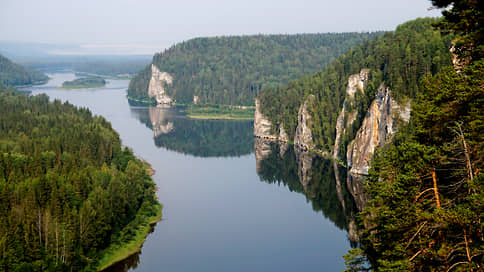Environmentalists warn of the threat of gold mining near the Vishera Reserve
[ad_1]

The Ministry of Natural Resources has published a draft of the new boundaries of the buffer zone of the Vishersky Reserve (Perm Territory). The department intends to protect the “unique natural complex from adverse anthropogenic impacts” and reduce the number of “illegal intrusions” into its territory. However, environmentalists point out that the document allows the development of gold deposits in the territories immediately adjacent to the reserve. According to them, this could damage the biodiversity of the Visherskoe, in particular, the sediment from gold mining threatens the population of the Red Book taimen.
The Ministry of Natural Resources has published for public discussion a document establishing new boundaries of the buffer zone along the perimeter of the Vishera nature reserve. Now such a zone is defined for the reserve only from the side of the Perm Territory, and the northern and eastern sides, coinciding with the borders of the Komi Republic and the Sverdlovsk Region, do not have a buffer zone. The explanatory note states that “the western and northwestern slopes of the mountain ranges have a high protected status, and visits to the eastern slopes belonging to the Sverdlovsk region are not limited to anything.” Therefore, “the majority of illegal entry into the reserve comes from the Sverdlovsk region.” The department is sure that the clarification of the boundaries of the buffer zone “will protect the unique natural complex and objects of the reserve from adverse anthropogenic impacts.”
The State Natural Reserve “Vishersky” is one of the ten largest reserves in Europe (area – 241.2 thousand hectares). It was founded in 1990. The protected area is located in the northeastern corner of the Perm Territory – on the border with the Komi Republic and the Sverdlovsk Region. The reserve almost completely covers the upper part of the Vishera river basin.
The Ministry of Natural Resources told Kommersant that “the requirement to define protected zones along the entire perimeter of specially protected natural areas is specified in federal legislation.” Separately, the department recalled that “the buffer zone of the reserve is not a protected area.” Nevertheless, the honored ecologist of Russia Vsevolod Stepanitsky believes that in the new position, “the devil is in the details.” He recalls that the ministry wants to create a new strip of the buffer zone along the northern and northeastern borders of the reserve, “and approve a single regulation for the entire buffer zone, including the existing site within the Perm Territory.”
The ecologist points out that gold deposits are located within the “old” buffer zone. “Earlier, licenses were issued for the development of subsoil plots there. But environmental legislation prohibits such work on the territory of the reserve, so gold is not mined there,” he says. The new document retains a ban on the exploration and development of minerals. But Mr. Stepanitsky points to a “reservation” in the draft regulation – “with the exception of carrying out these works within the existing licensed subsoil plots.” “It remains to approve the new provision – and the existing barrier on the way of gold miners disappears,” concludes the ecologist.
Mikhail Kreindlin, a member of the Expert Council on Reserve Affairs, shares his colleague’s concerns. “Currently, a license is valid within the boundaries of the buffer zone,” the expert points out. “According to the auction documentation, the calculation of placer gold reserves was made for the excavator-hydraulic mining method. Such a method will inevitably lead to a violation of the biodiversity of the territory.
“According to the rules for creating buffer zones of certain categories of protected areas, when determining the width and configuration of the buffer zone, the presence of deposits and manifestations of minerals on the territory is taken into account,” the Ministry of Natural Resources told Kommersant. “And the land plots that are included in the boundaries of the buffer zone, are not withdrawn from owners, land users, landowners and tenants. The agency confirmed that the document makes an exception for “already existing licensed subsoil plots,” but “in the rest of the protected zone, exploration and mining will be prohibited.”
In the Vels River basin, where the new regulation allows gold mining, there are Red Data Book species, including the osprey bird of prey.
Vladimir Melnikov, president of the Union for the Protection of Birds, notes that she chooses trees on higher ground for nesting because she needs to “inspect the territory.” “Regardless of whether the trees will be affected by the gold miners or not, the birds will be disturbed by the work,” explains Mr. Melnikov. “The process will be accompanied by the noise of machinery and people. The osprey will not be satisfied with this, the population may be lost.”
Concerns about rare species are also expressed by Dmitry Lisitsyn, an independent expert in the field of nature conservation. “The Red Book taimen is found in the river basin. Gold mining, especially alluvial gold mining, will harm all the fish in general,” Mr. Lisitsyn told Kommersant. “Downstream, sediment from gold washing will fall out, the river will silt up. As a result, fish may stop spawning here. And the caviar they lay will be of poor quality, so that the offspring will easily die.
The Ministry of Natural Resources is confident that the new document “will contribute to the conservation of biological diversity at the junction of regions and prevent poaching.”
The ministry also notes that “there are no settlements near the planned buffer zone, so its legal registration will not cause a negative reaction from the local population.” Public discussion of the project will last until August 25.
[ad_2]
Source link








